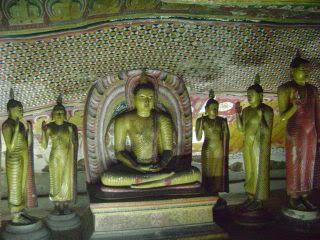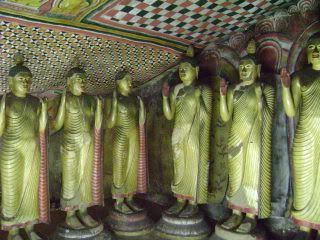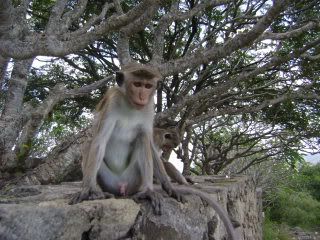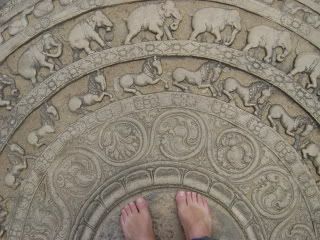Our flight was to an equally exotic location, Colombo, the capital of Sri Lanka. We got a fantastic last minute deal on Cathay Pacific, an airline based in Hong Kong. It was one of the nicest planes I've ever been on, and the service was great.
We landed in Colombo at 1 a.m. -- after adjusting our watches an unusual 90 minutes to meet the local time. Asians fly with an enormous amount of luggage, and we waited for nearly an hour to collect our bags in the small airport. Then it was a quick trip to the ATM -- it's unbelieveable you can go to almost any country on earth, stick a card in a machine, and get cash. My card, from a local bank in Texas, gives me fee-free withdrawals worldwide. We took a taxi out of the airport and into the sticky Sri Lankan night to a hotel in a nearby beach town. We were not asleep until nearly 3 a.m.
The Sri Lanka we saw when the sun came up was one both familiar and exotic. We took a tuktuk -- a sort of three wheeled contraption -- to the bus terminal and took a series of busses to get to Dambulla, which is not a very scenic town but is situation perfectly in the heart of Sri Lanka's Cultural Triangle.
For about 2,500 years the history of Sri Lanka has to a large extent been the history of Buddhism. Buddha found enlightenment under a bo tree in India a few hundred years before Jesus was born, and within a few years he had travelled to Sri Lanka.
DAMBULLA
Dambulla is an unattractive and dusty town at the base of a granite mountain. The top of the mountain has a huge overhand which starting at about 300 AD was filled in to create five caves. The dim caves are adorned with Buddhas and elaborate ceiling frescoes. The heat was intense and we stayed just a couple of hours before retreating to our hotel -- a nice one, with TV, a/c and a swimming pool.
(Dambulla caves)

POLUNNAWARA
Polunnawara, two hours north and east of Dambulla, was the capital of Sri Lanka for about 1000 years. Today it's a vast ruined city. We hired a tuktuk to take us around to the sites -- our guide book suggested renting a bicycle but with the temperature at 100 degrees with near equal humidity such an exercise was out of the question. Even being ferried around in the three-wheeled open sided contraption known as a tuktuk only offered us brief respite.
We've broken down this week and bought bottled water. Our UV pen water filter, cantankerous though it may be, is good at killing germs but apparently not effective at killing worms, which we've found in our UV filtered water several times.
(Dambulla caves)

SIGIRIYA
When the capital of Sri Lanka was not at Polunnawara, it was here, where the king resided atop a sheersided mountain today filled with ruins and monkeys. Halfway up the mountain, in a cave, are the untouched paintings of topless Sri Lankan maidens dating to the 4th Century.
ANAHADPURA
Andhadpura is not really a tourist site, though it is another of Sri Lanka's UNESCO World Heritage Sites. It was the home of an collection of extensive Buddhist monasteries.
The Buddha attained enlightenment under a bo tree, and soon after a cutting from that tree was taken to this spot and planted. Within a few years the original tree in India died, leaving this specimem. Today it's encircled with pilgrims praying beneath its huge canopy. Nearby are stark white dagobas, each said to house a relic of the Buddha. Just to the north is an enormous brick dagoba built on a footprint of the Buddha.
(Monkeys under a bo tree at Anahadpura)

KANDY
As the Buddha was being cremated someone ran into the pyre and grabbed one of his teeth. The tooth of the Buddha remained in India for years until it was threatened with destruction; it was then brought here, to Kandy, where it resides in a golden chamber sealed off. Hundreds of pilgrims pray in front of it daily, lay lotus flowers and light incense.
(12th Century floormat in Polunnawara)

Sri Lanka, perhaps more than any other country I've been to except Ethiopia, has the uncanny ability to awe you with its beauty and madden you with its idiosyncracies. Lankans are incredibly polite. I've never been called anything but sir, and Laura has never been called anything other than "the madam," even when being spoken to directly. At a dagoba in Anahadpura yesterday, a man had his children bow before us, he said, to show proper respect to visitors. Hotel workers bow and clasp their palms when addressing us. It's humbling and awesome. And yet, one very nice hotel we stayed at had bloody buggers smeared on the wall. You can't cross the road without risking your life. The food is "character building." The heat is insane. The beautiful stupas often have a pile of trash burning near their base.
We've got another week to go before we fly back to Bangkok.
1 comment:
I think it was Buddha who said: "He who smears bloody bugger on wall forfeits all AMEX rewards points."
Post a Comment